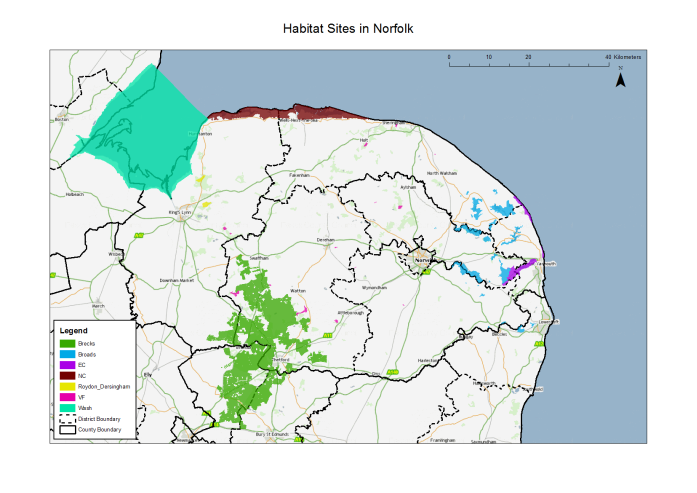108
Greater Norwich has and neighbours a wealth of natural environmental assets designated for both habitat and species protection. Many of these are marshland, rivers or broads of international and national status classified as Special Areas of Conservation (SACs), Special Protection Areas (SPAs) and Ramsar sites for wetland importance. The internationally protected European sites subject to the Habitats Regulations in the Broads and elsewhere in Norfolk, including on the coast, could potentially be affected by growth in Greater Norwich (see map 4 below).
109
Water quality is a major issue for the sensitive wetland habitats and dealing with pollution brings particular challenges. Increased pressure from housing growth within Greater Norwich combined with an increase in already high visitor numbers may also have potentially negative impacts on some sites. The GNLP must ensure that development does not have a negative impact on internationally designated sites, including minimising visitor impact and protecting water quality.
110
SACs in Greater Norwich itself include the Wensum chalk river valley and valleys and fens at Booton Common and Buxton Heath. There are also 45 nationally important Sites of Special Scientific Interest (SSSIs) designated for their biodiversity and geodiversity value. Pinebanks Pits in Thorpe St Andrew and Catton Chalk Pits are examples of sites designated for their geodiversity value.
111
In addition, Greater Norwich has large numbers of locally protected sites. There were 447 County Wildlife Sites covering around 4,700 hectares of land in 2018. Sites include valleys, meadows and wetlands, such as parts of the Bure, Waveney and Yare valleys, heaths such as Mousehold, grasslands including commons such as those at Hapton, Mulbarton and Salle, and an extensive network of hedgerows and woodlands spread across the area
Map 4 - Major Habitat Sites in Norfolk

Table 4 - Numbers of and internationally, nationally and locally designated nature conservation sites, 201541
| Feature | Greater Norwich numbers |
|---|---|
| Special Areas of Conservation | 3 |
| Special Protection Areas | 2 |
| Ramsar Sites | 2 |
| Sites of Special Scientific Interest | 45 |
| National Nature Reserves | 2 |
| Local Nature Reserves | 18 |
| Roadside Nature Reserves | 52 |
| County Wildlife Sites | 428 |
112
Long-term work is ongoing to improve and expand the green infrastructure network throughout Greater Norwich and beyond. Green infrastructure is vital to supporting biodiversity, combating climate change, reducing pollution, helping to create attractive homes and workplaces, enhancing landscapes, reducing flood risk and aiding active lifestyles and wellbeing.
113
As our area is located adjacent to the Broads and other areas of national and international importance, the aim is to provide sufficient high quality green spaces to provide biodiversity buffer zones, promote active leisure and travel and provide alternative destinations to help manage visitor pressure on biodiversity.
114
Parks and other types of open space also play an important role in providing a network of locally accessible green and urban spaces.
115
Overall, the plan should promote the protection, enhancement and delivery of a strategic green infrastructure network which addresses the scale of development proposed in the plan. It must be capable of protecting species, supporting habitats and delivering a wider range of environmental services to meet development needs.
Footnotes
41Sources: Norfolk Biodiversity Information Service and Natural England. Some sites have several designations, so are counted more than once in the table.